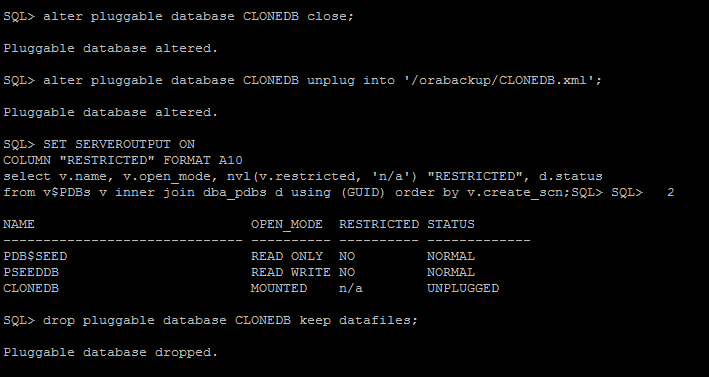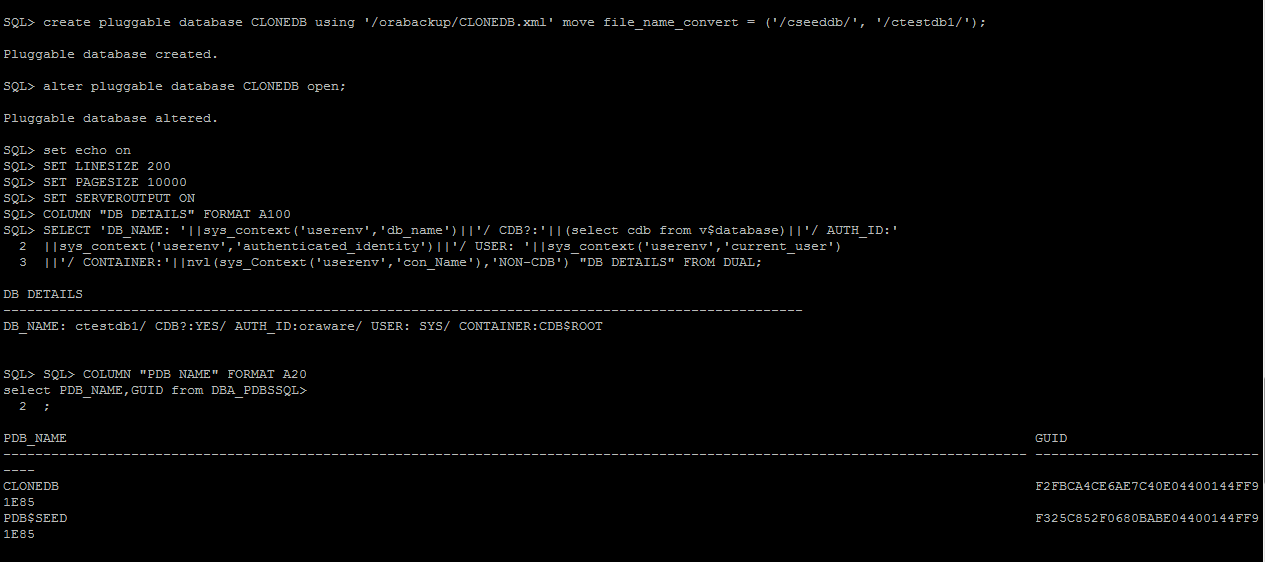How to clone Pluggable Database from one container to different Container Database
How to clone Pluggable Database from one container to different Container Database
Cloning and Refresh are day-to-day activity which DBA perform on regular basic. In today blog , We will discuss about Cloning of the pluggable database from one container database to different container database.
Oracle offers to unplug a PDB from one CDB and then plug into a different CDB. This will be another additional feature of PDB to give the highest availability and scalability the database systems may need in a cloud infrastructure environment.
1)We have two container database cseeddb(Source Container DB) and ctestdb1 (target container DB).
NOTE: We have created container DB ctestdb1 and it does not have any PDB(Pluggable DB).

2)Verify you are in the correct container database root namespace(CDB).
NOTE: We are on first container (cseeddb) database where we have clonedb pluggable database which we will move in to another empty container ctestdb1.
NOTE: We are on first container (cseeddb) database where we have clonedb pluggable database which we will move in to another empty container ctestdb1.
SQL> set echo on
SQL> SET LINESIZE 200
SQL> SET PAGESIZE 10000
SQL> SET SERVEROUTPUT ON
SQL> COLUMN "DB DETAILS" FORMAT A100
SQL> SELECT 'DB_NAME: '||sys_context('userenv','db_name')||'/ CDB?:'||(select cdb from v$database)||'/ AUTH_ID:'
||sys_context('userenv','authenticated_identity')||'/ USER: '||sys_context('userenv','current_user')
||'/ CONTAINER:'||nvl(sys_Context('userenv','con_Name'),'NON-CDB') "DB DETAILS" FROM DUAL;
SQL> SET LINESIZE 200
SQL> SET PAGESIZE 10000
SQL> SET SERVEROUTPUT ON
SQL> COLUMN "DB DETAILS" FORMAT A100
SQL> SELECT 'DB_NAME: '||sys_context('userenv','db_name')||'/ CDB?:'||(select cdb from v$database)||'/ AUTH_ID:'
||sys_context('userenv','authenticated_identity')||'/ USER: '||sys_context('userenv','current_user')
||'/ CONTAINER:'||nvl(sys_Context('userenv','con_Name'),'NON-CDB') "DB DETAILS" FROM DUAL;
DB DETAILS
----------------------------------------------------------------------------------------------------
DB_NAME: cseeddb/ CDB?:YES/ AUTH_ID:oraware/ USER: SYS/ CONTAINER:CDB$ROOT
----------------------------------------------------------------------------------------------------
DB_NAME: cseeddb/ CDB?:YES/ AUTH_ID:oraware/ USER: SYS/ CONTAINER:CDB$ROOT
SQL> SET SERVEROUTPUT ON
SQL>COLUMN "RESTRICTED" FORMAT A10
SQL>select v.name, v.open_mode, nvl(v.restricted, 'n/a') "RESTRICTED", d.status
from v$PDBs v inner join dba_pdbs d using (GUID) order by v.create_scn;
SQL>COLUMN "RESTRICTED" FORMAT A10
SQL>select v.name, v.open_mode, nvl(v.restricted, 'n/a') "RESTRICTED", d.status
from v$PDBs v inner join dba_pdbs d using (GUID) order by v.create_scn;
NAME OPEN_MODE RESTRICTED STATUS
------------------------------ ---------- ---------- -------------
PDB$SEED READ ONLY NO NORMAL
PSEEDDB READ WRITE NO NORMAL
CLONEDB READ WRITE NO NORMAL
------------------------------ ---------- ---------- -------------
PDB$SEED READ ONLY NO NORMAL
PSEEDDB READ WRITE NO NORMAL
CLONEDB READ WRITE NO NORMAL
3) On cseeddb Container database , Close, unplug and drop CLONEDB Pluggable DB with keep datafile..
SQL> alter pluggable database CLONEDB close;
Pluggable database altered.
SQL> alter pluggable database CLONEDB unplug into '/orabackup/CLONEDB.xml';
Pluggable database altered.
SQL> SET SERVEROUTPUT ON
SQL> COLUMN "RESTRICTED" FORMAT A10
SQL> select v.name, v.open_mode, nvl(v.restricted, 'n/a') "RESTRICTED", d.status
from v$PDBs v inner join dba_pdbs d using (GUID) order by v.create_scn;
SQL> COLUMN "RESTRICTED" FORMAT A10
SQL> select v.name, v.open_mode, nvl(v.restricted, 'n/a') "RESTRICTED", d.status
from v$PDBs v inner join dba_pdbs d using (GUID) order by v.create_scn;
NAME OPEN_MODE RESTRICTED STATUS
------------------------------ ---------- ---------- -------------
PDB$SEED READ ONLY NO NORMAL
PSEEDDB READ WRITE NO NORMAL
CLONEDB MOUNTED n/a UNPLUGGED
------------------------------ ---------- ---------- -------------
PDB$SEED READ ONLY NO NORMAL
PSEEDDB READ WRITE NO NORMAL
CLONEDB MOUNTED n/a UNPLUGGED
SQL> drop pluggable database CLONEDB keep datafiles;
Pluggable database dropped.

SQL> COLUMN "RESTRICTED" FORMAT A10
SQL> select v.name, v.open_mode, nvl(v.restricted, 'n/a') "RESTRICTED", d.status
from v$PDBs v inner join dba_pdbs d using (GUID) order by v.create_scn;
4) Verify you are on correct container database.
SQL> set echo on
SQL> SET LINESIZE 200
SET PAGESIZE 10000
SQL> SQL> SET SERVEROUTPUT ON
SQL> COLUMN "DB DETAILS" FORMAT A100
SQL> SELECT 'DB_NAME: '||sys_context('userenv','db_name')||'/ CDB?:'||(select cdb from v$database)||'/ AUTH_ID:'
||sys_context('userenv','authenticated_identity')||'/ USER: '||sys_context('userenv','current_user')
||'/ CONTAINER:'||nvl(sys_Context('userenv','con_Name'),'NON-CDB') "DB DETAILS" FROM DUAL;
SQL> SET LINESIZE 200
SET PAGESIZE 10000
SQL> SQL> SET SERVEROUTPUT ON
SQL> COLUMN "DB DETAILS" FORMAT A100
SQL> SELECT 'DB_NAME: '||sys_context('userenv','db_name')||'/ CDB?:'||(select cdb from v$database)||'/ AUTH_ID:'
||sys_context('userenv','authenticated_identity')||'/ USER: '||sys_context('userenv','current_user')
||'/ CONTAINER:'||nvl(sys_Context('userenv','con_Name'),'NON-CDB') "DB DETAILS" FROM DUAL;
DB DETAILS
----------------------------------------------------------------------------------------------------
DB_NAME: ctestdb1/ CDB?:YES/ AUTH_ID:oraware/ USER: SYS/ CONTAINER:CDB$ROOT
SQL> SET SERVEROUTPUT ON
COLUMN "RESTRICTED" FORMAT A10
select v.name, v.open_mode, nvl(v.restricted, 'n/a') "RESTRICTED", d.status
from v$PDBs v inner join dba_pdbs d using (GUID) order by v.create_scn;
COLUMN "RESTRICTED" FORMAT A10
select v.name, v.open_mode, nvl(v.restricted, 'n/a') "RESTRICTED", d.status
from v$PDBs v inner join dba_pdbs d using (GUID) order by v.create_scn;
NAME OPEN_MODE RESTRICTED STATUS
------------------------------ ---------- ---------- -------------
PDB$SEED READ ONLY NO NORMAL
5) Check Compatibility for plugging database.
SQL> SET SERVEROUTPUT ON
DECLARE
compatible CONSTANT VARCHAR2(3) :=
CASE DBMS_PDB.CHECK_PLUG_COMPATIBILITY(
pdb_descr_file => '/orabackup/CLONEDB.xml',
pdb_name => 'CLONEDB')
WHEN TRUE THEN 'YES'
ELSE 'NO'
END;
BEGIN
DBMS_OUTPUT.PUT_LINE(compatible);
END;
/
DECLARE
compatible CONSTANT VARCHAR2(3) :=
CASE DBMS_PDB.CHECK_PLUG_COMPATIBILITY(
pdb_descr_file => '/orabackup/CLONEDB.xml',
pdb_name => 'CLONEDB')
WHEN TRUE THEN 'YES'
ELSE 'NO'
END;
BEGIN
DBMS_OUTPUT.PUT_LINE(compatible);
END;
/
NO
NOTE: If the scripts returns NO, then check PDB_PLUG_IN_VIOLATIONS view
Compare both container compatibility using below command :
SQL> col cause for a10
col name for a10
col message for a35 word_wrapped
select name,cause,type,message,status from PDB_PLUG_IN_VIOLATIONS where name='CLONEDB';
col name for a10
col message for a35 word_wrapped
select name,cause,type,message,status from PDB_PLUG_IN_VIOLATIONS where name='CLONEDB';
NAME CAUSE TYPE MESSAGE STATUS
---------- ---------- --------- ----------------------------------- ---------
CLONEDB Parameter WARNING CDB parameter processes mismatch: PENDING
Previous 300 Current 100
---------- ---------- --------- ----------------------------------- ---------
CLONEDB Parameter WARNING CDB parameter processes mismatch: PENDING
Previous 300 Current 100
CLONEDB Parameter WARNING CDB parameter memory_target PENDING
mismatch: Previous 2147483648
Current 1073741824
mismatch: Previous 2147483648
Current 1073741824
Do not proceed unless you resolve all the issue of the reported by above query.
6) Plug Pluggable database .
SQL> create pluggable database CLONEDB using '/orabackup/CLONEDB.xml' move file_name_convert = ('/cseeddb/', '/ctestdb1/');
Pluggable database created.
SQL> alter pluggable database CLONEDB open;
Pluggable database altered.
SQL> set echo on
SQL> SET LINESIZE 200
SQL> SET PAGESIZE 10000
SQL> SET SERVEROUTPUT ON
SQL> COLUMN "DB DETAILS" FORMAT A100
SQL> SELECT 'DB_NAME: '||sys_context('userenv','db_name')||'/ CDB?:'||(select cdb from v$database)||'/ AUTH_ID:'
2 ||sys_context('userenv','authenticated_identity')||'/ USER: '||sys_context('userenv','current_user')
3 ||'/ CONTAINER:'||nvl(sys_Context('userenv','con_Name'),'NON-CDB') "DB DETAILS" FROM DUAL;
SQL> SET LINESIZE 200
SQL> SET PAGESIZE 10000
SQL> SET SERVEROUTPUT ON
SQL> COLUMN "DB DETAILS" FORMAT A100
SQL> SELECT 'DB_NAME: '||sys_context('userenv','db_name')||'/ CDB?:'||(select cdb from v$database)||'/ AUTH_ID:'
2 ||sys_context('userenv','authenticated_identity')||'/ USER: '||sys_context('userenv','current_user')
3 ||'/ CONTAINER:'||nvl(sys_Context('userenv','con_Name'),'NON-CDB') "DB DETAILS" FROM DUAL;
DB DETAILS
----------------------------------------------------------------------------------------------------
DB_NAME: ctestdb1/ CDB?:YES/ AUTH_ID:oraware/ USER: SYS/ CONTAINER:CDB$ROOT
----------------------------------------------------------------------------------------------------
DB_NAME: ctestdb1/ CDB?:YES/ AUTH_ID:oraware/ USER: SYS/ CONTAINER:CDB$ROOT
SQL> COLUMN "PDB NAME" FORMAT A20
SQL> select PDB_NAME,GUID from DBA_PDBS;
PDB_NAME GUID
-------------- --------------------------------
CLONEDB F2FBCA4CE6AE7C40E04400144FF91E85
PDB$SEED F325C852F0680BABE04400144FF91E85
-------------- --------------------------------
CLONEDB F2FBCA4CE6AE7C40E04400144FF91E85
PDB$SEED F325C852F0680BABE04400144FF91E85
7)Verify Container and Pluggable DB in target Container database.
SQL> SET SERVEROUTPUT ON
SQL> COLUMN "RESTRICTED" FORMAT A10
SQL> select v.name, v.open_mode, nvl(v.restricted, 'n/a') "RESTRICTED", d.status
from v$PDBs v inner join dba_pdbs d using (GUID) order by v.create_scn;
SQL> COLUMN "RESTRICTED" FORMAT A10
SQL> select v.name, v.open_mode, nvl(v.restricted, 'n/a') "RESTRICTED", d.status
from v$PDBs v inner join dba_pdbs d using (GUID) order by v.create_scn;
NAME OPEN_MODE RESTRICTED STATUS
---------- ---------- ---------- -------------
PDB$SEED READ ONLY NO NORMAL
CLONEDB READ WRITE NO NORMAL
SQL> SQL> set echo on
SQL> SET LINESIZE 200
SQL> SET PAGESIZE 10000
SQL> SET SERVEROUTPUT ON
SQL> COLUMN "DB DETAILS" FORMAT A100
SQL> SELECT 'DB_NAME: '||sys_context('userenv','db_name')||'/ CDB?:'||(select cdb from v$database)||'/ AUTH_ID:'
||sys_context('userenv','authenticated_identity')||'/ USER: '||sys_context('userenv','current_user')
||'/ CONTAINER:'||nvl(sys_Context('userenv','con_Name'),'NON-CDB') "DB DETAILS" FROM DUAL;
SQL> SET LINESIZE 200
SQL> SET PAGESIZE 10000
SQL> SET SERVEROUTPUT ON
SQL> COLUMN "DB DETAILS" FORMAT A100
SQL> SELECT 'DB_NAME: '||sys_context('userenv','db_name')||'/ CDB?:'||(select cdb from v$database)||'/ AUTH_ID:'
||sys_context('userenv','authenticated_identity')||'/ USER: '||sys_context('userenv','current_user')
||'/ CONTAINER:'||nvl(sys_Context('userenv','con_Name'),'NON-CDB') "DB DETAILS" FROM DUAL;
DB DETAILS
----------------------------------------------------------------------------------------------------
DB_NAME: ctestdb1/ CDB?:YES/ AUTH_ID:oraware/ USER: SYS/ CONTAINER:CDB$ROOT
SQL> select name, cdb from v$database;
NAME CDB
---------- ---
CTESTDB1 YES
---------- ---
CTESTDB1 YES
Please read below books in order to know more about oracle CDB and PDB databases:
================================================================
You can also , Visit our Blogs for related topic on Pluggable and Container database:







Comments
Post a Comment
Please do not enter any spam link in comment Section suggestions are Always Appreciated. Thanks.. !